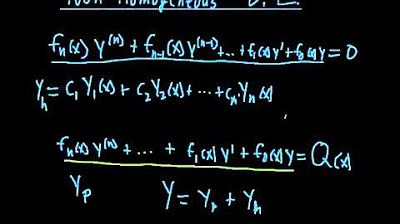Solving Differential Equations with Power Series: A Simple Example
Summary
TLDRIn this video, the lecturer explores the solution to a first-order linear differential equation, exemplified by phenomena like population growth, loan interest, and radioactive decay. The solution is derived using a power series expansion (Taylor series), progressively solving for each coefficient in the series. The lecturer demonstrates how this method leads to the definition of the exponential function e^(at) and its power series representation. The technique, which involves matching terms in the power series, is a powerful tool in solving more complex differential equations, including nonlinear systems and special functions like Bessel and Airy functions.
Takeaways
- 😀 The script discusses the solution to a first-order linear differential equation with real-world applications like population growth, compound interest, and radioactive decay.
- 😀 The general form of the differential equation is presented as x dot equals a times x, where the derivative of x with respect to time is proportional to x.
- 😀 The solution to this equation is found to be x(t) = e^(at) * x₀, where x₀ is the initial condition at time t=0.
- 😀 The script demonstrates how to derive the exponential function from scratch using a Taylor series expansion.
- 😀 A Taylor series expansion of x(t) is assumed, and its derivative is taken to match the equation x dot = a * x.
- 😀 Through this method, the coefficients of the Taylor series are determined recursively to match the differential equation.
- 😀 The recursive relationship is derived, showing how each coefficient is related to the previous one in the series.
- 😀 The approach is generalized for higher powers of t, demonstrating how each term of the expansion is calculated.
- 😀 This technique of solving differential equations using power series can be applied to more complex equations and non-linear systems, such as Bessel or Airy functions.
- 😀 The exponential function e^(at) is derived as a series, providing a deep connection to Euler's work on the exponential function and its general properties.
- 😀 The entire process illustrates how a Taylor series expansion can be used to solve ordinary differential equations and derive important mathematical functions like the exponential function.
Q & A
What is the primary focus of the lecture in the transcript?
-The primary focus of the lecture is solving a first-order linear differential equation using a power series (Taylor series) expansion to derive the exponential function.
What is the general form of the differential equation discussed in the transcript?
-The differential equation discussed is ẋ = ax, where ẋ represents the derivative of x with respect to time, and a is a proportionality constant.
What does the term 'ẋ' in the differential equation represent?
-The term 'ẋ' represents the derivative of x with respect to time, indicating the rate of change of x over time.
What method does the lecturer use to solve the differential equation?
-The lecturer uses a power series or Taylor series expansion to solve the differential equation and derive the exponential function.
What is the Taylor series expansion of x(t) used for in this context?
-The Taylor series expansion of x(t) is used to approximate the solution of the differential equation by expressing x(t) as an infinite series of powers of t.
How does the lecturer derive the coefficients in the power series expansion?
-The lecturer derives the coefficients by differentiating the series expression for x(t), multiplying it by a, and then equating the resulting expression to the derivative of x(t) to match corresponding powers of t.
What is the significance of matching the terms of the Taylor series for x(t) and ẋ?
-Matching the terms of the Taylor series for x(t) and ẋ ensures that the differential equation ẋ = ax is satisfied for every power of t, leading to a recursive relationship for the coefficients.
How does the recursive relationship for the coefficients help in solving the differential equation?
-The recursive relationship allows each coefficient to be expressed in terms of the previous coefficient, ultimately leading to a general formula for the coefficients in the power series, which can be used to express the solution x(t).
What is the final expression for x(t) derived in the lecture?
-The final expression for x(t) is x(t) = x₀ * (1 + at + a²t²/2! + a³t³/3! + ...), which is the Taylor series expansion of e^(at).
What mathematical concept does the lecturer connect this solution to?
-The lecturer connects the solution to the concept of the exponential function, specifically e^(at), which is derived from the Taylor series expansion.
Outlines

This section is available to paid users only. Please upgrade to access this part.
Upgrade NowMindmap

This section is available to paid users only. Please upgrade to access this part.
Upgrade NowKeywords

This section is available to paid users only. Please upgrade to access this part.
Upgrade NowHighlights

This section is available to paid users only. Please upgrade to access this part.
Upgrade NowTranscripts

This section is available to paid users only. Please upgrade to access this part.
Upgrade NowBrowse More Related Video

Fungsi Eksponen Pertumbuhan dan Peluruhan

Representing Real Life Situations Using Exponential Functions (General Mathematics)

General Solution to Non-Homogeneous DE

APLIKASI BARISAN & DERET (PERTUMBUHAN, PELURUHAN, BUNGA TUNGGAL, BUNGA MAJEMUK, ANUITAS)

Introduction to Differential Equations (Differential Equations 2)

A concept of Differential Equation
5.0 / 5 (0 votes)